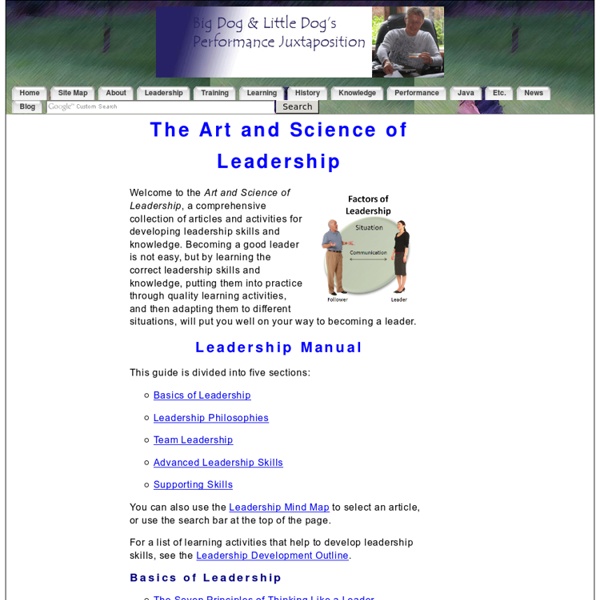Leaders Eat Last by Simon Sinek : Book Summary
Why Some Teams Pull Together and Others Don't by Simon Sinek Author: Simon Sinek • Book Summary by Dean Bokhari The main message of Leaders Eat Last is simple -- the buck stops at the leader’s desk. In other words, those of us that lead may not always understand the impact that our leadership roles actually have on those we lead.
Leadership
Theories[edit] Early western history[edit] The trait theory was explored at length in a number of works in the 19th century. Most notable are the writings of Thomas Carlyle and Francis Galton, whose works have prompted decades of research.[4] In Heroes and Hero Worship (1841), Carlyle identified the talents, skills, and physical characteristics of men who rose to power. In Galton's Hereditary Genius (1869), he examined leadership qualities in the families of powerful men. After showing that the numbers of eminent relatives dropped off when moving from first degree to second degree relatives, Galton concluded that leadership was inherited.
Pedagogy of Presence
Micro-processes- Cultivating Internal Conditions Within the current context of schooling, we are engaging teachers in classrooms right now with a method and process for a Pedagogy of Presence in the form of a 12 session self-study program. This approach provides teachers with inquiry-based tools to identify and overcome obstacles to achieving the goals most urgent to children’s enduring success.
10 Coaching Questions Every Leader Needs to Ask
The best coaches also receive coaching. They also regularly coach themselves. Let me explain. If you are like me, your are enticed by routines because they allow you to feel comfortable.
Top 7 Ways To Remain Focused
Single-minded determination is not something that many of us can honestly say that we have on a regular basis. There might be the odd moments of concentrated "will-power" or flashes of inspired effort, but for most of us, lack of confidence, confusion or simply information overload causes us to be easily distracted from our path. When faced with two equally attractive opportunities, have you ever lost energy pursuing both at the same time with the inevitable consequence of neither of them panning out? Do you remember doing your homework in front of the TV or listening to the radio? Your focus and attention may not have been at its highest level, a fact born out the next day when you panicked to correct all the mistakes or to complete the assignment.
Are You Asking the Right Questions?
Great Results Begin With Great Questions ~ Joseph S Edwards Do good managers do the work for their staff ? Or do they lead them to creatively think through the dilemma so they can develop the right skills to problem solve going forward? On Courage and Questions
18 Ways to Stay Focused at Work
Over the years I have worked at many client sites and a variety of office layouts. On one project in particular, we had as many as 80 people in a project team, seated via an open plan arrangement. It was pretty difficult trying to stay focused in an environment like this. These days, the projects I’m on are typically smaller, but there are still a number of distractions which frequently interrupt my working groove. So what are some of the things we can do to minimise such interruptions and distractions?
10 Common Leadership & Management Mistakes - Leadership Skills from MindTools
Avoiding Universal Pitfalls Avoid common leadership and management mistakes. © iStockphoto/Laflor
11 ways of staying focused
Each of us have our busy lives and in this world of constant distractions, how can we stay focused on our goals? This article discusses several techniques I have found to work. For me, there are always several things constantly competing for my time – articles to write, business opportunities to explore, links to follow up, my daily work, personal commitments etc. In my experience whenever I try to work on many things at the same time, none of them actually gets done. In response, I’ve incorporated the following techniques for staying focused into my work patterns:
leadership training, leadership tips, theory, skills, for leadership training and development
home » leadership/management » leadership leadership development methods and tips This leadership tips webpage is a general guide to modern ethical progressive leadership. See also the leadership theories article for explanations and summaries of the main leadership theories.



